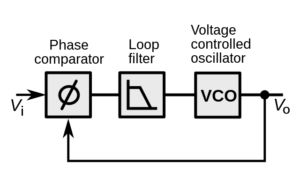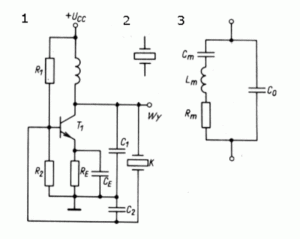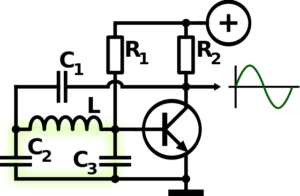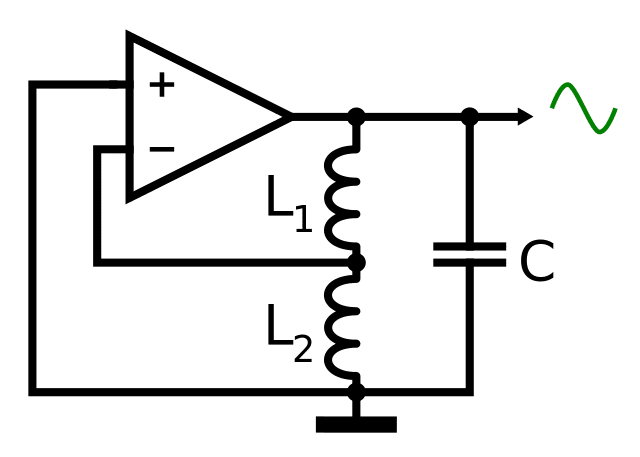



Start Here
Oscillator Circuits and Phase-Locked Loops (PLLs)
In this chapter, we delve into the world of oscillator circuits and phase-locked loops (PLLs), fundamental components in electronic systems, particularly in frequency generation and control. The chapter begins by exploring different types of oscillators – Hartley, Colpitts, and Pierce – each distinguished by its unique method of coupling positive feedback to the input. For instance, the Hartley oscillator utilizes a tapped coil, while the Colpitts and Pierce oscillators use a capacitive divider and capacitive coupling, respectively. These mechanisms are crucial for maintaining the continuous oscillations needed in various applications. The chapter also discusses the importance of stability in oscillators, especially in variable frequency oscillators (VFOs) and PLL frequency synthesizers. Understanding the principles behind these oscillators, including how they manage feedback and ensure stability, is essential for anyone involved in designing or working with electronic circuits, particularly in communication and signal processing.
Be sure to login to your hamshack.ca account to track your progress by clicking the [Mark Complete] Button at the bottom of each lesson. You can contact VE7DXE to sign-up for the new Basic Amateur course.
Positive Feedback in Hartley Oscillator (A-005-001-001)
Coupling Mechanism in Hartley Oscillator: Question A-005-001-001 inquires about the method of coupling positive feedback to the input in a Hartley oscillator. The correct answer, B. Through a tapped coil, explains that in Hartley oscillators, a coil with a tap provides the feedback necessary to sustain oscillations. This tap effectively splits the coil, allowing a portion of the inductor to be used in the feedback path. The tapped coil configuration is akin to a self-sustaining system, where part of the output is looped back to keep the process ongoing, essential for the continuous generation of a stable oscillation frequency.
Parallels:
- Water Recycling in a Fountain: Like a water fountain recycling some water back to its reservoir, the Hartley oscillator uses a tapped coil to recycle part of the signal for continuous operation.
- Looped Track in Athletics: Similar to runners using a looped track for continuous laps, the Hartley oscillator’s tapped coil creates a feedback loop for ongoing signal generation.
Question Summary and Key Takeaways:
- Tapped Coil for Feedback: Integral for sustaining oscillations in a Hartley oscillator.
- Self-Sustaining Mechanism: Essential for the continuous generation of signals.
- Stable Frequency Production: Allows for the creation of a consistent oscillation frequency.
- Design Simplicity: Demonstrates an efficient method to achieve feedback.
- Key Component in Oscillator Design: Vital for oscillator functionality and reliability.

Positive Feedback in Colpitts Oscillator (A-005-001-002)
Feedback Mechanism in Colpitts Oscillator: Question A-005-001-002 focuses on how positive feedback is coupled to the input in a Colpitts oscillator. The answer, A. Through a capacitive divider, explains that in Colpitts oscillators, a capacitive divider, consisting of two or more capacitors in series, is used to provide the necessary feedback. This setup creates a phase shift and feedback loop, critical for sustaining oscillations. The capacitive divider can be likened to a balancing act, where the right division of the signal ensures a continuous back-and-forth motion, akin to a well-timed swing, enabling the oscillator to produce a stable waveform.
Parallels:
- Seesaw Balance: Like balancing a seesaw, the capacitive divider balances the feedback signal for steady oscillations in a Colpitts oscillator.
- Swing Motion: Similar to a swing’s back-and-forth motion, the capacitive divider creates a feedback loop that keeps the oscillator signal moving steadily.
Question Summary and Key Takeaways:
- Capacitive Divider for Feedback: Central to the operation of Colpitts oscillators.
- Phase Shift and Stability: Crucial for generating and sustaining oscillations.
- Controlled Feedback Loop: Ensures a consistent and stable signal output.
- Design Efficiency: Demonstrates an effective way to achieve necessary feedback.
- Widely Used in RF Oscillators: Popular in radio frequency applications for its reliability.

Positive Feedback in Pierce Oscillator (A-005-001-003)
Feedback System in Pierce Oscillator: In Question A-005-001-003, the method of coupling positive feedback in a Pierce oscillator is explored. The correct response, C. Through capacitive coupling, highlights that Pierce oscillators use capacitive coupling to provide the necessary feedback for oscillation. This method involves a capacitor in the feedback path, creating a loop that ensures the continuous operation of the oscillator. The capacitive coupling acts as a conduit for the signal, akin to a hidden passageway, maintaining the flow and consistency of the oscillation, essential for precise frequency generation in applications like crystal oscillators.
Parallels:
- Circular Water Flow in a Pond: The capacitive coupling in a Pierce oscillator is like a circular water flow system in a pond, ensuring continuous movement.
- Belt in a Conveyor System: Similar to a conveyor belt transporting items in a loop, capacitive coupling in the Pierce oscillator maintains a continuous signal loop.
Question Summary and Key Takeaways:
- Capacitive Coupling for Feedback: Key to sustaining oscillations in Pierce oscillators.
- Consistent Oscillation Flow: Ensures a steady and uninterrupted signal.
- Precise Frequency Generation: Ideal for applications requiring high-frequency stability.
- Simple yet Effective Design: Demonstrates an efficient feedback mechanism.
- Common in Crystal Oscillators: Widely used due to its effectiveness in precise frequency control.

Stability of Colpitts Oscillators in VFOs (A-005-001-004)
Colpitts Oscillator in Variable Frequency Oscillators: Question A-005-001-004 asks why the Colpitts oscillator circuit is commonly used in Variable Frequency Oscillators (VFOs). The answer, C. It is stable, points out the key reason for its popularity: stability. The Colpitts oscillator is known for its reliable performance, maintaining a constant frequency even under varying conditions. This stability is crucial in VFOs, as it allows for precise tuning across a range of frequencies without drifting, much like a well-balanced spinning top that maintains its position despite external influences. This characteristic makes it an ideal choice in applications where frequency accuracy and consistency are paramount.
Parallels:
- Steady Ship in Rough Waters: Like a ship remaining stable in turbulent seas, the Colpitts oscillator maintains steady frequency in VFOs amidst varying conditions.
- Balanced Gyroscope: Similar to a gyroscope maintaining orientation, the Colpitts oscillator in a VFO ensures consistent frequency stability.
Question Summary and Key Takeaways:
- Stability in Frequency Tuning: Key advantage of Colpitts oscillators in VFOs.
- Reliable Performance: Maintains frequency accuracy under different conditions.
- Ideal for Frequency Control: Suitable for applications requiring precise frequency adjustments.
- Prevents Frequency Drift: Ensures accurate tuning without off-target drifting.
- Popular in Radio Systems: Commonly used in radio transmitters and receivers for its reliability.
Stability of PLL Frequency Synthesizers (A-005-001-005)
Importance of a Stable Reference Oscillator in PLLs: Question A-005-001-005 explores why a highly stable reference oscillator is crucial in a Phase-Locked Loop (PLL) frequency synthesizer. The correct answer, C. Any phase variations in the reference oscillator signal will produce phase noise in the synthesizer output, highlights the impact of the reference oscillator’s stability on the synthesizer’s output quality. In a PLL, the reference oscillator sets the standard against which the synthesizer operates. Any instability or phase variation in this reference can lead to phase noise, adversely affecting the output signal’s purity and clarity. This stability is akin to the steady beat of a drum in a band, ensuring that all instruments (synthesized frequencies) stay in rhythm and harmony.
Parallels:
- Foundation of a Building: The reference oscillator in a PLL is like the foundation of a building; any instability can compromise the entire structure (synthesized signal).
- Heartbeat in a Body: Similar to how a steady heartbeat is crucial for bodily functions, a stable reference oscillator is vital for the synthesizer’s proper operation.
Question Summary and Key Takeaways:
- Critical for Phase Noise Reduction: Stability in the reference oscillator minimizes phase noise.
- Sets the Standard for PLL: Acts as the baseline for frequency synthesis.
- Impact on Signal Quality: Ensures the purity and clarity of the output signal.
- Necessity in Communication Systems: Essential in applications requiring precise frequency control.
- Determinant of Synthesizer Performance: A key factor in the overall effectiveness of PLL frequency synthesizers.

Positive Feedback in Colpitts Oscillators (A-005-001-006)
Identifying Colpitts Oscillators: Question A-005-001-006 asks about identifying the type of oscillator that uses positive feedback from a capacitive divider. The answer, B. Colpitts, indicates that the Colpitts oscillator is characterized by this specific feedback mechanism. The capacitive divider, typically consisting of two or more capacitors, creates the necessary phase shift for sustained oscillations. This setup is a defining feature of Colpitts oscillators, allowing them to generate stable and reliable signals, much like a well-tuned instrument in an orchestra that consistently produces the right notes.
Parallels:
- Balancing Act in a Circus: The capacitive divider in a Colpitts oscillator is like an acrobat’s balancing act, maintaining the perfect equilibrium for ongoing performance.
- Pendulum Clock Mechanism: Similar to how a pendulum clock uses a precise mechanism for timekeeping, the Colpitts oscillator uses a capacitive divider for stable oscillation.
Question Summary and Key Takeaways:
- Capacitive Divider as Key Feature: Distinct characteristic of Colpitts oscillators.
- Phase Shift for Oscillation: Essential for creating and maintaining signal oscillations.
- Stable Signal Generation: Known for producing reliable and consistent frequencies.
- Recognizable Design: A unique identifier among oscillator types.
- Widely Used in RF Applications: Popular due to its stability and effectiveness.
High Stability RF Oscillator Design (A-005-001-007)
Capacitor Choice for Stability in RF Oscillators: In Question A-005-001-007, the focus is on selecting capacitors for high stability in RF oscillator circuits. The correct answer, A. Silver mica, underscores the preference for silver mica capacitors in such applications. These capacitors are chosen for their excellent stability and low loss characteristics, essential in maintaining a consistent frequency in high-stability RF oscillators. Silver mica capacitors are akin to precision instruments in an orchestra, where accuracy and consistency are key to the overall performance.
Parallels:
- Precision Tools in Engineering: Like using precision tools for accurate measurements, silver mica capacitors ensure exact frequency control in RF oscillators.
- High-Performance Sports Equipment: Similar to athletes using specialized equipment for consistency, silver mica capacitors provide stable performance in oscillator circuits.
Question Summary and Key Takeaways:
- Ideal for High Stability: Silver mica capacitors are preferred for their precision.
- Low Loss Characteristics: Essential for minimal signal degradation.
- Consistent Frequency Maintenance: Key in applications requiring exact frequency control.
- Suitable for RF Oscillators: Widely used in radio frequency circuits for their reliability.
- Quality Component Selection: Important in designing high-performance oscillator circuits.

Identifying Pierce Oscillators (A-005-001-008)
Positive Feedback in Pierce Oscillators: Question A-005-001-008 queries about the oscillator type where positive feedback is achieved through a single capacitor in series with a crystal. The correct answer, D. Pierce, identifies the Pierce oscillator, distinguished by this specific feedback arrangement. The combination of a crystal and a capacitor in the feedback loop is a hallmark of the Pierce oscillator, facilitating stable and precise frequency generation. This configuration can be likened to a finely calibrated machine where each component plays a critical role in ensuring optimal performance.
Parallels:
- Key in a Lock Mechanism: The capacitor-crystal combination in a Pierce oscillator is like a key fitting perfectly into a lock, ensuring precise operation.
- Tuning a Musical Instrument: Similar to fine-tuning a stringed instrument for accurate pitch, the Pierce oscillator uses its unique configuration for exact frequency control.
Question Summary and Key Takeaways:
- Capacitor-Crystal Feedback Loop: Defining feature of Pierce oscillators.
- Stable Frequency Generation: Provides highly accurate and stable oscillations.
- Unique Design Identifier: A clear indicator of the Pierce oscillator type.
- Precision in Oscillation Control: Ideal for applications requiring exact frequency tuning.
- Widespread Use in Electronics: Commonly employed in crystal oscillator circuits.
Role of Positive Feedback in Oscillators (A-005-001-009)
Positive Feedback in Variable-Frequency Oscillators: Question A-005-001-009 addresses the role of positive feedback in certain circuits. The answer, B. Variable-frequency oscillator, highlights that circuits relying on positive feedback, such as Variable Frequency Oscillators (VFOs), use this mechanism for continuous tuning across a range of frequencies. Positive feedback in VFOs allows the oscillator to adjust its frequency smoothly and continuously, akin to a musician smoothly transitioning between notes on an instrument. This feature is crucial in applications like radio communication, where tuning across different frequencies is required.
Parallels:
- Adjusting a Bicycle’s Speed: Like adjusting the speed on a bicycle to navigate different terrains, positive feedback in a VFO allows smooth frequency changes.
- Sliding Scale in Measurements: Similar to using a sliding scale for various measurements, a VFO adjusts frequencies with positive feedback for versatility.
Question Summary and Key Takeaways:
- Continuous Frequency Tuning: Positive feedback enables smooth frequency adjustments in VFOs.
- Versatility in Frequency Control: Allows for a wide range of frequency settings.
- Crucial in Radio Communication: Key for tuning to different stations or channels.
- Smooth Transition Between Frequencies: Ensures seamless frequency changes.
- Essential in Electronic Design: A fundamental component in communication systems.
CW Transmitter Design (A-005-001-010)
Oscillator and Amplifier in CW Transmitters: Question A-005-001-010 explores the apparatus comprising an oscillator and a class C amplifier. The correct answer, C. A two-stage CW transmitter, identifies this combination as typically found in Continuous Wave (CW) transmitters used for Morse code communication. The oscillator generates the carrier wave, while the class C amplifier boosts the signal for transmission. This setup is analogous to a musical performance where one instrument creates the melody and another amplifies it for the audience.
Parallels:
- Musical Duo in a Performance: The oscillator and class C amplifier in a CW transmitter work like a musical duo, one creating the tune and the other amplifying it.
- Engine and Exhaust in Cars: Similar to an engine generating power and the exhaust system boosting output, the oscillator generates signals and the amplifier strengthens them for transmission.
Question Summary and Key Takeaways:
- Combination in CW Transmitters: Oscillator and amplifier work together in CW transmission.
- Signal Generation and Amplification: Oscillator creates the wave, amplifier boosts it.
- Ideal for Morse Code Communication: Suitable for transmitting Morse code signals.
- Efficient Signal Transmission: Ensures effective broadcasting of CW signals.
- Key in Amateur Radio: A fundamental setup in amateur radio operations.
Feedback Mechanism in Pierce Oscillators (A-005-001-011)
Feedback in Pierce Oscillators: Question A-005-001-011 explores the type of feedback mechanism used in a Pierce oscillator. The answer, C. Pierce, indicates that positive feedback is provided through a capacitor in series with a crystal. This unique configuration characterizes the Pierce oscillator, which is widely used in crystal oscillator circuits. The capacitor, in conjunction with the crystal, forms a resonant circuit that provides the necessary feedback for oscillation. This setup is crucial for maintaining a stable and precise frequency, making the Pierce oscillator a popular choice in applications where accuracy is key, such as in clock circuits and communication systems.
Parallels:
- Synchronized Swimming: The coordinated movement in synchronized swimming, where each motion complements the other, mirrors how the capacitor and crystal work together in the Pierce oscillator to maintain steady oscillations.
- Tuning a Guitar with a Tuning Fork: Just as a tuning fork helps to precisely set a guitar string’s pitch, the crystal in the Pierce oscillator provides a precise frequency reference, ensuring accurate oscillations.
Question Summary and Key Takeaways:
- Capacitor-Crystal Feedback Loop: Essential for the Pierce oscillator’s functionality.
- Stable and Precise Frequency: The oscillator is known for its accuracy, ideal for sensitive applications.
- Popular in Electronic Circuits: Widely used in timing and communication devices.
- Efficiency in Design: Demonstrates a simple yet effective feedback mechanism.
- Crucial for Accurate Timing: Important in systems where precise timing is critical.
Exploring Oscillators and PLLs in Electronic Systems
Throughout this chapter, we’ve gained a comprehensive understanding of several types of oscillators and their roles in electronic systems. We explored the unique feedback mechanisms of Hartley, Colpitts, and Pierce oscillators, each contributing to the generation of stable and consistent oscillations. The use of tapped coils, capacitive dividers, and capacitive coupling in these oscillators underscores the diversity of techniques employed to achieve desired oscillatory behavior. We also examined why stability is a key attribute in Colpitts oscillators when used in VFOs and the critical role of a stable reference oscillator in PLL frequency synthesizers to avoid phase noise. Additionally, we discussed the significance of silver mica capacitors in high-stability RF oscillators and the identification of oscillator types based on their feedback mechanisms. This exploration not only enhances our understanding of oscillator circuits and PLLs but also highlights their indispensable role in modern electronic applications, from basic signal generation to complex communication systems.
© Hamshack.ca. All lesson content, diagrams, and quizzes are proprietary and protected by copyright. Access is for personal use only and requires a valid course purchase where applicable. Copying, sharing, or redistributing any material is strictly prohibited. See the Hamshack.ca Terms of Use for full details.
